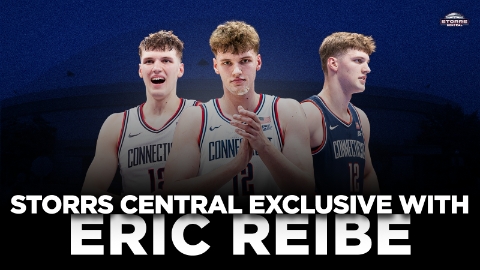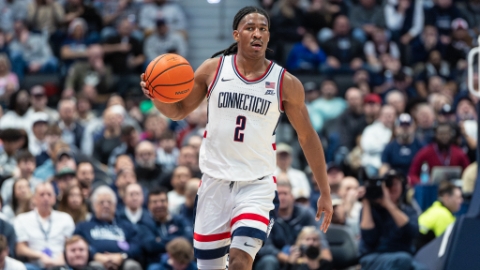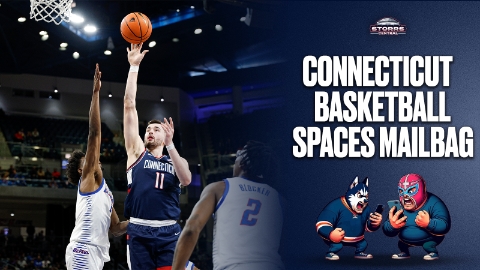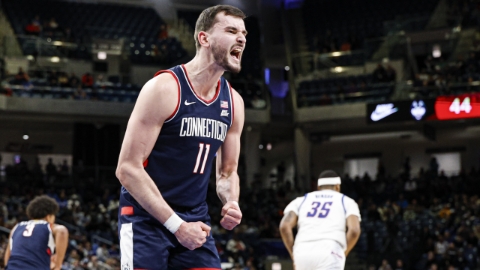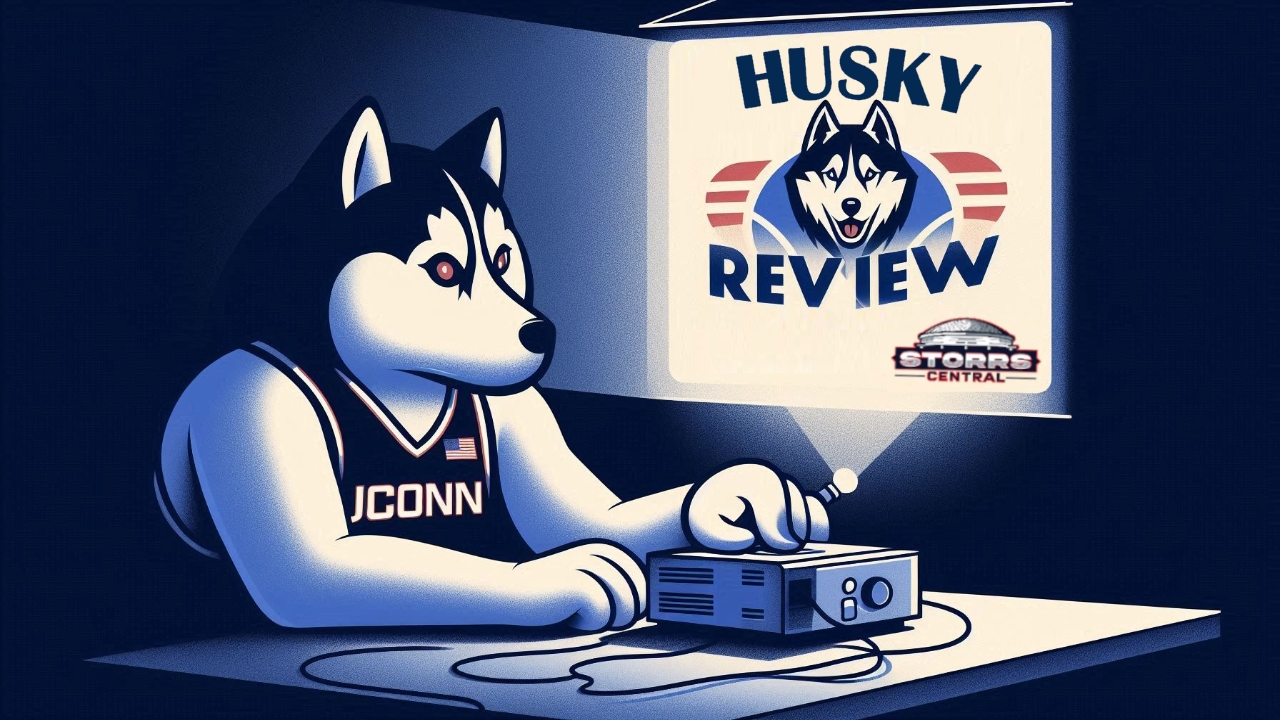
So. Uh.
…
What happened?
How did UConn fall so short of expectations in Maui?
Here are the Huskies’ points per possession scored and allowed for all 3 games in Maui, along with the season averages from the first 4 games.
| Team | Type | Points per Possession |
|---|---|---|
| First Four Game Average | Off | 1.28 |
| Def | 0.74 | |
| Memphis | Off | 1.31 |
| Def | 1.34 | |
| Colorado | Off | 1.18 |
| Def | 1.20 | |
| Dayton | Off | 1.03 |
| Def | 1.31 | |
| Maui Average | Off | 1.18 |
| Def | 1.29 |
As we can see from the chart, what happened is that the defense was not up to the task. The offense was still mostly good – against Memphis it was exceptional and against Dayton the team’s subpar three point shooting led to it being more pedestrian. UConn allowed at least 1.20 points per possession in all 3 games and averaged 1.29 against in Maui. For comparison, the Huskies gave up 1.20 points per possession or higher in only 3 games all of last season – at Seton Hall (1.20), at Creighton (1.45), and at St. John’s (1.32) in BET. Noteworthy that 2 of UConn’s 3 losses were beyond that threshold and all were played in an opponent’s home gym. The other loss, at Kansas, was close at 1.15 points per possession allowed. The Huskies’ defensive performances in all 3 games at Maui on a neutral court were comparabale to the team’s worst efforts last season on the road.
So where were the defensive results particularly weak? We can look to Dean Oliver’s Four Factors (Shooting, Rebounding, Turnovers, and Free Throws) to see:

Torvik has this data handily color-coded based on D1 averages for easy digestion. The first thing to see is that there is zero green on this chart at all. Which means the team’s defense was not good in any single category. The Huskies did an okay job rebounding and forcing turnovers (could’ve used a bit more pressure against Dayton, maybe), but the rest was quite poor. Free throw rate and three-point defense were especially bad. However, defenses have limited control over opponent success on three-point shots, and the Maui rims make it a shooter’s paradise. Just ask Tyrese Hunter.
So the team gets some leeway when it comes to opponent shooting. Memphis, Dayton, and Colorado all shot well in most of their other games (with Colorado's lone exception being a rough night against Michigan State). Still, bad luck only explains so much—UConn's three-point defense clearly struggled. A big part of that was the need to provide extra help against drives and pick-and-rolls and occasionally with doubling the post. This often put Husky defenders in late or longer closeouts and/or teammates bogged down in communication instead of moving automatically. This is an example of where weaker aspects of your defense can lead to worse results in another seemingly unrelated statistical area.
For example, here’s a play against Colorado.
UConn defends this action relatively well. Samson stops the pentration with a hedge, but the first small mistake is that Stewart fails to prevent the pass to Samson’s man. He at least makes the angle difficult, which gives Alex time to rotate over, and then Samson time to recover, which then allows Alex to recover back to his man. At this point, the scheme is working more or less as intended. However, the center makes a nice skip pass to the open man in the far corner, which leads to further rotations. Unfortunately, both Diarra and Solo head to the corner man, leaving Diarra’s man wide open on the wing for a 3.
Details in coverage and rotation were missed consistently throughout the games. One area of specific concern was matching up in transition. Watch Samson on this play:
Karaban picked up Samson’s man correctly due to a transition cross-match, and Samson jogs back and doesn’t really seem to know what to do. He ends up stopping directly in front of Solo, leaving Karaban’s man wide open on the wing and also not helping Karaban in the paint. It’s not what you expect to see from a senior. There was a similar play at the end of the Dayton game that resulted in a dagger three to pretty much end the game.
With defense, it’s hard to know when the issue is the scheme or the player’s execution of the scheme. Against Memphis, when Diarra was the low man, he was shading far off his man into the paint to assist against drivers and pick and rolls. This is a fairly standard coverage. But when it’s a side pick and roll and the offensive player short rolls instead of rolling all the way to the basket, it is unclear to me if the coaches want Diarra to stunt/guard the opposing center all the way at the foul line, which leads to an impossible closeout to the wing, even for someone with Diarra’s speed. Either way, Reed needs to be quicker getting back to his man and replacing Diarra.
A similar coverage in the next clip, with McNeeley as the low man helping in the paint. However, Karaban’s man runs through and McNeeley’s man lifts up to the wing. Karaban and McNeeley need to either switch who they are guarding, or Karaban should become the new low man and McNeeley go out to his man. But McNeeley is not on the same page as Karaban, they take a second to communicate, and McNeeley is late on the long closeout. Despite the shooter bobbling the pass, he still has an open three.
I don’t intend to call out these players, or at least not only these players, for their execution. Other players were guilty of various defensive lapses and struggles, especially in 1v1 responsibilities. Some were hunted on defense, but even our strongest man-to-man defenders got beat and scored on over these 3 games.
The worst aspect of the team’s play on the trip was unquestionably the fouling, and the statistics from the Torvik chart back that up. The worst season-long free throw rate for any team last seaosn was 49.2%, and the Huskies’ best game performance this week was a 60% defensive free throw rate. The issue was not isolated to a single player or position group or single game. Make no mistake, UConn was playing hard and physical for the most part throughout the tournament. At times, it was too physical, and it was often not smart. Memphis, especially PJ Haggerty, looked to draw fouls on every possession. UConn was not disciplined enough or savvy enough with their positioning to avoid committing those fouls.
Hurley took umbrage with many of the calls, citing the physicality of the game on both ends. But often they were “by the rulebook” fouls that the officials were choosing to enforce at a higher rate than he’d prefer, at times exaggerated by the opponent. UConn was not driving enough itself to earn the same volume of calls, instead running its movement offense that generates open shots, not contested drives that lead to whistle-happy refs rewarding your initiative. The scenario put UConn at a disadvantage, but the team and staff did not adapt to the whistle. With their invincibility shattered, the Huskies reflected their coach. They resorted far too often to reaching in or going for rebounds or blocks extra aggressively with a fiery desperation in order to make a decisive play, as opposed to playing solid, calm defense. Hurley’s very public beratement of the officials over the course of the weekend potentially made it tougher for his players as well.
Fouling doesn’t just help your opponent score easily due to free throws. In the Colorado game, 5 players were called for 2 fouls in the first half (Karaban, Johnson, Reed, Ross, and Diarra). Rotations, substitution patterns, lineups, and schemes go out the window with that sort of availability upheaval. If you sit for an extended period, you can go cold and lose all of your rhythm. Alex sat for close to 11 minutes of game time to end the half and went about an hour of real world time between taking shots. He shot 0/6 in the second half. The other obvious downside is fouling out. Both centers fouling out was probably the primary reason the team ended up losing the Colorado game – the Buffaloes scored 2 paint buckets to take the lead in the last 2 minutes.
While this aticle focused mainly on the defensive side of the court, there was one growing area of concern offensively. Following the Memphis game, which was a normal effort by UConn standards, the team’s offensive rebounding fell off a cliff in the last 2 games. Colorado and Dayton were able to keep the Huskies off the boards, which has been a key area of efficiency for Hurley’s Huskies the last several seasons. Without offensive rebounding, UConn becomes much more of a jump shooting-reliant team. Reed has been one of the best offensive rebounders in the country, but was kept off the o-boards against Colorado and then only played 14 minutes against Dayton.
